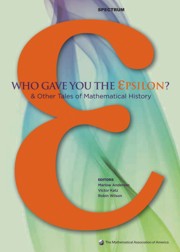Book contents
- Frontmatter
- Introduction
- Contents
- Analysis
- Geometry, Topology and Foundations
- Algebra and Number Theory
- Foreword
- Hamilton's Discovery of Quaternions
- Hamilton, Rodrigues, and the Quaternion Scandal
- Building an International Reputation: The Case of J. J. Sylvester (1814–1897)
- The Foundation Period in the History of Group Theory
- The Evolution of Group Theory: A Brief Survey
- The Search for Finite Simple Groups
- Genius and Biographers: The Fictionalization of Evariste Galois
- Hermann Grassmann and the Creation of Linear Algebra
- The Roots of Commutative Algebra in Algebraic Number Theory
- Eisenstein's Misunderstood Geometric Proof of the Quadratic Reciprocity Theorem
- Waring's Problem
- A History of the Prime Number Theorem
- A Hundred Years of Prime Numbers
- The Indian Mathematician Ramanujan
- Emmy Noether
- “ Marvelous Proof,”
- Afterword
- Surveys
- Index
- About the Editors
Emmy Noether
from Algebra and Number Theory
- Frontmatter
- Introduction
- Contents
- Analysis
- Geometry, Topology and Foundations
- Algebra and Number Theory
- Foreword
- Hamilton's Discovery of Quaternions
- Hamilton, Rodrigues, and the Quaternion Scandal
- Building an International Reputation: The Case of J. J. Sylvester (1814–1897)
- The Foundation Period in the History of Group Theory
- The Evolution of Group Theory: A Brief Survey
- The Search for Finite Simple Groups
- Genius and Biographers: The Fictionalization of Evariste Galois
- Hermann Grassmann and the Creation of Linear Algebra
- The Roots of Commutative Algebra in Algebraic Number Theory
- Eisenstein's Misunderstood Geometric Proof of the Quadratic Reciprocity Theorem
- Waring's Problem
- A History of the Prime Number Theorem
- A Hundred Years of Prime Numbers
- The Indian Mathematician Ramanujan
- Emmy Noether
- “ Marvelous Proof,”
- Afterword
- Surveys
- Index
- About the Editors
Summary
The past two years have seen a surge of interest in Emmy Noether and her mathematics. Along with Auguste Dick's biography of her, listed below, Constance Reid's biography, Hilbert, frequently mentions Emmy Noether. New mathematics books, such as Introduction to the Calculus of Variations by Hans Sagan, and Commutative Rings by Irving Kaplansky, are spreading anew her methods, and the adjective “noetherian” abounds in titles to papers in mathematics research journals. The State University of New York at Buffalo has just set up a GeorgeWilliam Hill–Emmy Noether Fellowship. A high school textbook, Modern Introductory Analysis, by Dolciani, Donnelly, Jurgensen, and Wooten, devotes a page to Emmy Noether. And one finds such remarks in periodical literature as “The woman mathematician today is better off than Emmy Noether, who taught without pay. But …”.
Despite all this recent interest, it is difficult to find much about Emmy Noether in mathematics history books. Although she was dubbed “der Noether” by P. S. Alexandroff, and that name with its masculine German article has stuck, she is given only a footnote in E.T.Bell's Men of Mathematics and hardly more in comparable books. In fact, little else can be found about her than three obituary addresses and the biography published just last year:
Emmy Noether, by Hermann Weyl (memorial address at Bryn Mawr College, April 26, 1935), Scripta Mathematica 3 (1935), 201–220.
Nachruf auf Emmy Noether, by B. L. van der Waerden (in German), Mathematische Annalen111 (1935), 469–476.
Emmy Noether, by P. S. Alexandroff, address to the Moscow Mathematical Society, Sept. 5, 1935.
Emmy Noether, by Auguste Dick (in German), Birkhäuser Verlag, 1970.
- Type
- Chapter
- Information
- Who Gave You the Epsilon?And Other Tales of Mathematical History, pp. 349 - 359Publisher: Mathematical Association of AmericaPrint publication year: 2009

